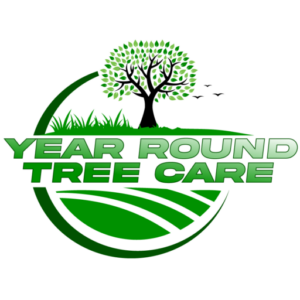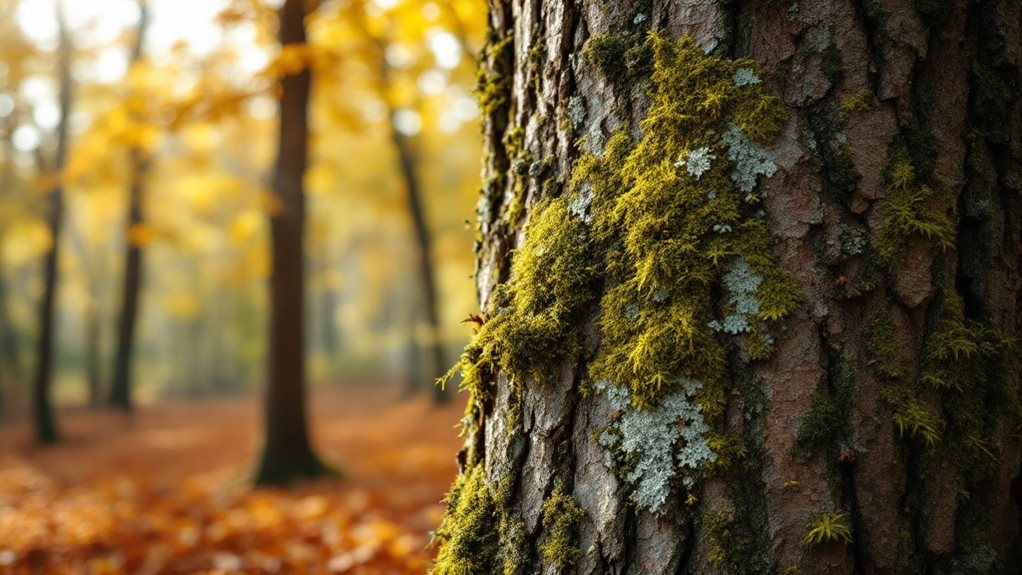
Tree Health Spotlights
You'll spot warning signs of tree health through regular inspections of the crown, trunk, and root system. Watch for yellowing leaves, dead branches, unusual bark patterns, and fungal growth that signal potential problems. Modern diagnostic tools like sonic tomography and thermal imaging can help detect hidden issues early. Professional arborists use these indicators alongside seasonal assessments to develop effective care strategies – understanding these key signals will transform how you protect your trees.
Expert Highlights
- Regular crown inspections reveal early signs of stress through leaf density, color changes, and dead branch patterns.
- Modern diagnostic tools like sonic tomography and thermal imaging provide accurate internal health assessments without damaging trees.
- Environmental factors in urban settings, including soil compaction and limited root space, significantly impact tree health.
- Seasonal inspections throughout the year help identify specific health concerns and guide appropriate treatment timing.
- Professional arborists use standardized protocols and documentation to track tree health history and implement preventive care strategies.
The Essential Components of a Tree Health Assessment
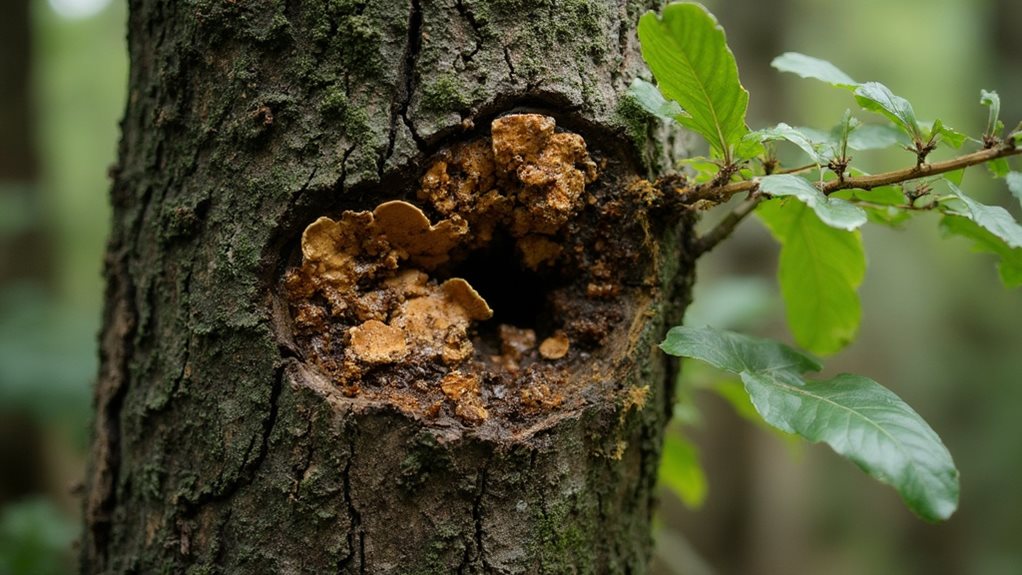
When conducting a tree health assessment, you'll need to evaluate several key components that work together to indicate the overall condition of the tree.
Start by examining the tree's crown for dead branches, leaf density, and proper growth patterns. Check the trunk for wounds, decay, or unusual swelling that might signal internal problems.
Inspect the root flare and surrounding soil for signs of stress, poor drainage, or exposed roots.
You'll want to look for pest infestations, disease symptoms, and structural issues that could compromise the tree's stability.
Don't forget to note the tree's growing environment, including soil conditions, available space, and potential conflicts with structures or utilities.
Document any recent changes in the area that might affect the tree's health.
Visual Signs of Tree Stress and Disease
You'll quickly spot a troubled tree by watching for telltale changes in leaf color, from yellowing to browning to premature fall.
Check the trunk for visible wounds, fungal growth, or unusual bark patterns that might indicate internal decay or pest problems.
Examine the tree's branch structure for signs of irregular growth, including dead twigs, excessive crossing branches, or uneven development on one side.
Leaf Color Changes
Three key color changes in tree leaves can signal serious health problems.
You'll need to watch for yellowing leaves outside of fall season, which often indicates nitrogen deficiency or root stress. Brown spots or patches on leaves typically point to fungal infections or chemical burn from improper fertilizer use.
When you notice leaves turning purple or reddish prematurely, your tree may be suffering from phosphorus deficiency or physical damage to its trunk.
You can help prevent these issues by maintaining proper soil pH, ensuring adequate drainage, and avoiding over-fertilization.
If you're uncertain about the cause of leaf discoloration, consider collecting samples to show an arborist. Quick identification of these color changes allows you to address underlying problems before they become severe.
Trunk Damage Signs
Inspecting your tree's trunk regularly can reveal critical signs of disease and stress. Look for vertical cracks, peeling bark, or sunken areas that might indicate internal decay.
Watch for fungal growth, which often appears as shelf-like structures or discolored patches on the bark. You'll want to check for insect evidence, including small holes, sawdust-like material, or oozing sap.
Dark or wet spots on the trunk can signal bacterial infection or pest infestation. Pay special attention to the tree's base, where mechanical damage from lawn equipment often occurs.
If you spot cankers – dead sections of bark with raised or discolored edges – your tree likely has a fungal or bacterial infection that requires immediate attention.
Early detection of these issues helps prevent further decline and supports successful treatment.
Branch Growth Patterns
While healthy trees display balanced, symmetrical growth patterns, abnormal branch development often signals underlying health issues. You'll notice diseased trees may show clusters of small branches, called witch's brooms, or exhibit stunted growth on one side.
These irregularities can indicate nutrient deficiencies, pest infestations, or fungal diseases. Watch for branches that grow at unusual angles or cross over each other, as this can create weak points and increase the risk of breakage.
If you spot excessive dead branches or sections with no leaf growth during the growing season, your tree may be struggling with root problems or systemic disease. Early detection of these growth abnormalities will help you take prompt action to save the tree and prevent further decline.
Modern Tools and Technology in Tree Diagnostics
As technology advances, arborists now have access to sophisticated diagnostic tools that revolutionize how they assess and monitor tree health. You'll find that sonic tomography devices can detect internal decay without damaging the tree, while thermal imaging cameras reveal areas of stress and disease. These tools help you provide better care for your community's trees.
Digital monitoring systems now allow you to track a tree's moisture levels, nutrient uptake, and growth patterns in real-time. You can use portable DNA testing kits to identify specific pathogens quickly, and drone technology offers extensive aerial views of canopy health.
With smartphone apps and cloud-based platforms, you're able to maintain detailed records and share data with other tree care professionals, ensuring more accurate diagnoses and treatment plans.
Root System Evaluation Methods
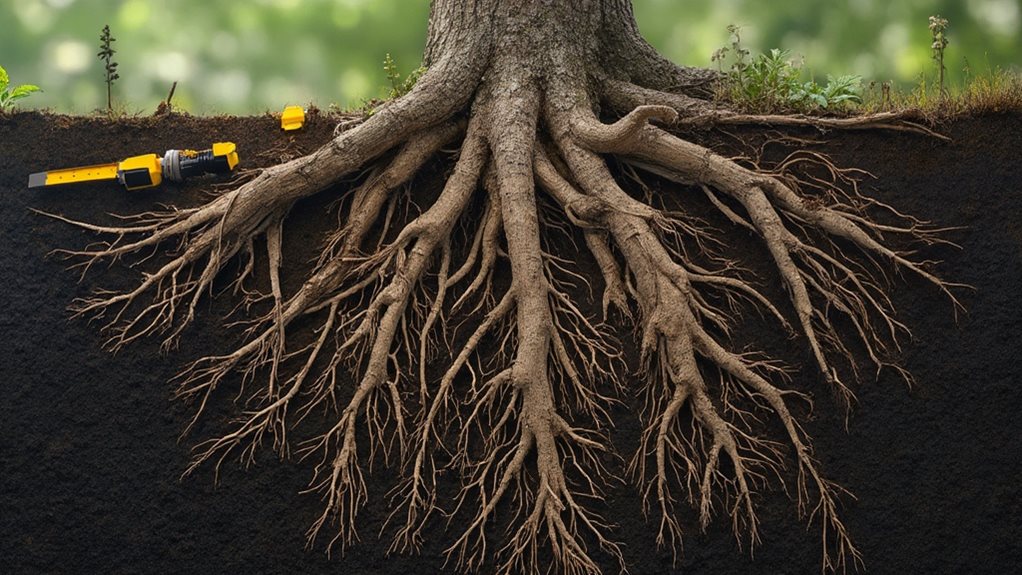
Because roots form the foundation of tree health, understanding their condition requires multiple evaluation approaches.
Tree health depends on strong roots – evaluating them thoroughly requires diverse assessment methods to build a complete picture.
You'll need both visual assessments and specialized tools to get a complete picture of root health.
You can start with surface observations, looking for exposed roots, soil heaving, and fungal growth.
Next, use a soil probe to check root density and distribution.
For deeper analysis, you'll want to employ ground-penetrating radar or acoustic tomography to map the root system's structure without excavation.
When you're dealing with potential root problems, consider air excavation techniques.
They'll help you examine roots directly while minimizing damage.
Don't forget to assess soil compaction using a penetrometer – it's essential for determining if roots have adequate growing conditions.
Common Urban Tree Health Challenges
When you're evaluating urban tree health, you'll find soil compaction among the most damaging issues, as it restricts root growth and water penetration.
Limited root space in city environments forces trees to develop stunted or deformed root systems that can't properly support the tree's needs.
These challenges, combined with environmental stresses like heat islands and air pollution, create significant obstacles for urban trees' long-term survival.
Soil Compaction Problems
One of the most damaging urban tree challenges, soil compaction occurs from constant foot traffic, vehicle parking, and construction activities that squeeze soil particles together.
This compression restricts root growth, reduces water infiltration, and limits oxygen availability to tree roots. You'll notice affected trees showing signs of stress through yellowing leaves, stunted growth, and premature leaf drop.
- You'll feel heartbroken watching your community's beloved trees struggle to survive in compacted soil.
- You'll experience frustration seeing roots unable to expand and nourish the tree.
- You'll worry as water pools around the tree instead of reaching the roots.
- You'll be inspired to take action when you understand how protecting soil structure saves trees.
To help your trees thrive, consider installing protective barriers, using mulch rings, and redirecting foot traffic away from root zones.
Limited Root Space
Beyond soil compaction, urban trees face another major challenge: limited root space. In urban environments, trees often struggle with confined growing areas due to sidewalks, buildings, and underground utilities.
These restrictions prevent roots from spreading naturally and accessing necessary water and nutrients.
You'll notice that trees in tight spaces show signs of stress through stunted growth, early leaf drop, and thin canopies. To help trees thrive despite space limitations, you can select species that match the available growing space, use structural soil systems, or install root barriers that guide roots downward rather than laterally.
When planning new tree installations, calculate the mature tree's root space requirements and guarantee adequate soil volume for healthy growth. This forethought will promote long-term tree success in urban settings.
Environmental Stress Impacts
Urban trees endure multiple environmental stresses that can severely impact their health and longevity.
You'll notice these stresses manifest in ways that affect both the tree's appearance and essentiality.
Air pollution, extreme temperatures, road salt exposure, and water fluctuations create challenging conditions for urban trees to thrive.
- Your neighborhood trees gasp for clean air as vehicle emissions and industrial pollutants coat their leaves, blocking essential photosynthesis.
- Watch helplessly as scorching heat waves cause leaves to wilt and branches to die back.
- Notice how winter road salt burns tree roots and damages soil structure, slowly poisoning your community's trees.
- See stressed trees struggle to access consistent water supplies between drought periods and flash floods.
Seasonal Timing for Tree Health Inspections
Regular tree inspections throughout the year are vital for maintaining healthy trees and preventing potential problems. You'll want to conduct thorough checks during specific seasonal windows for ideal results.
In early spring, examine your trees for winter damage and emerging leaf buds.
Summer inspections should focus on leaf health, pest activity, and signs of drought stress.
Fall is essential for evaluating branch structure before leaf drop and preparing trees for winter.
During winter, you can easily spot structural issues like crossed branches or splits in the bare canopy.
Don't forget to inspect after severe weather events, regardless of season.
Look for hanging branches, root exposure, or trunk damage.
Professional Arborist Techniques and Protocols
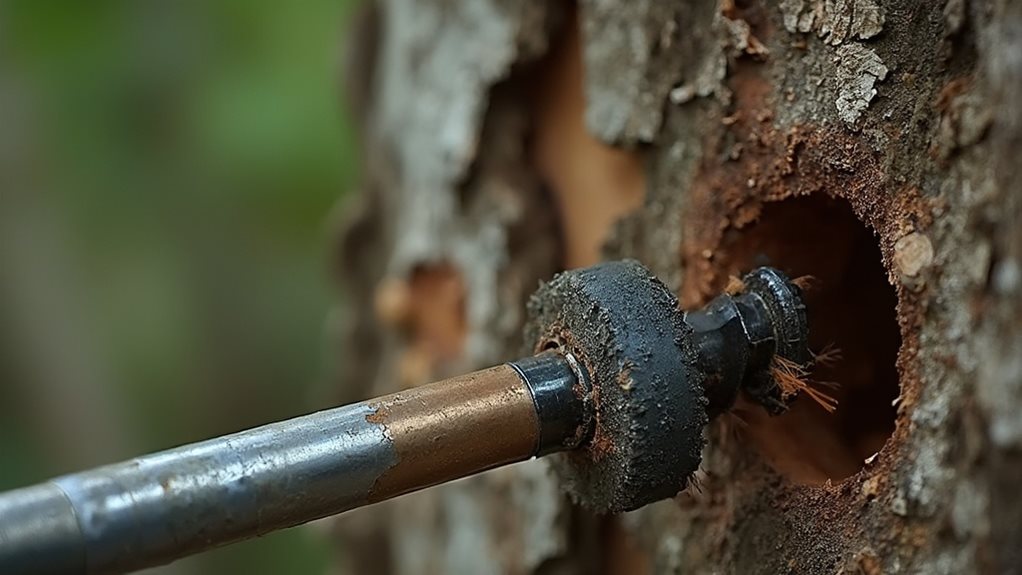
Professional arborists rely on specific techniques and standardized protocols to guarantee accurate tree assessments and effective care.
You'll find that proper diagnosis combines visual inspection, specialized tools, and systematic documentation to protect and preserve trees in your community. Understanding these methods helps you support the essential work of tree care professionals.
- Master the gentle art of crown inspection, where you'll discover early signs of stress before they become serious threats to your neighborhood's beloved trees.
- Learn soil sampling techniques that reveal the hidden stories of root health and nutrient needs.
- Practice precision pruning methods that promote healing while maintaining the tree's natural beauty.
- Document your findings meticulously, creating a valuable health history that helps future caretakers serve these living landmarks.
Preventive Care Strategies and Management Plans
Successful tree management begins with a proactive approach to preventive care and long-term planning. You'll need to establish regular inspection schedules, maintain detailed health records, and implement seasonal care routines for your trees.
Create a customized management plan that includes proper mulching, structured pruning cycles, and soil testing protocols. You'll want to map out irrigation schedules based on local climate patterns and specific tree species requirements.
Monitor for early signs of disease or pest infestation, and document any treatments applied.
Consider developing response protocols for extreme weather events and potential hazards. By integrating preventive measures with regular maintenance tasks, you'll help guarantee your trees remain healthy and resilient.
Remember to adjust your management strategies based on each tree's growth stage and environmental conditions.
Frequently Asked Questions
Can Trees Recover on Their Own After Being Struck by Lightning?
You'll find that trees can recover from lightning strikes if they're not severely damaged. However, they'll need your monitoring for disease and decay in the damaged areas over time.
How Long Does It Typically Take for a Newly Planted Tree to Establish?
You'll typically see a newly planted tree establish in 2-3 years, though it'll depend on the species, soil conditions, and how well you've maintained proper watering and care practices.
What Kind of Music, if Any, Helps Trees Grow Better?
While there's no scientific evidence that music directly helps trees grow, you'll find that sound vibrations might stimulate growth. Focus instead on proper watering, soil health, and sunlight exposure.
Do Trees Communicate With Each Other When Facing Threats From Insects?
You'll find that trees do communicate through chemical signals and underground fungal networks, warning neighboring trees about insect attacks so they can boost their natural defense mechanisms.
Is It True That Talking to Trees Helps Them Grow Stronger?
You won't help trees grow stronger just by talking to them, but your carbon dioxide breath and attention to their care can positively impact their health and development.
Expert Final Thougts
You'll find that regular tree health assessments are crucial for maintaining your urban forest. By understanding visual symptoms, using modern diagnostic tools, and following proper inspection timing, you're better equipped to protect your trees. Don't wait for obvious problems – implement preventive strategies now and consult qualified arborists when needed. Your proactive approach will guarantee healthier, longer-lasting trees in your landscape.
